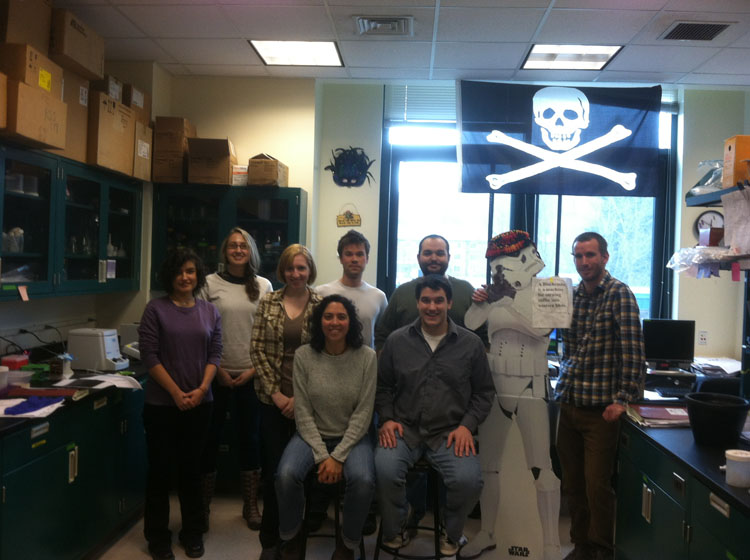Karatan Lab
Home
Ece Karatan
karatane@appstate.edu
Appalachian State University
Department of Biology
Rankin Science North
319 (Office), 303 (Lab)
828-262-6742
Karatan Lab is located in the Department of Biology at Appalachian State University. The main focus of the reseach in our lab is biofilm formation in Vibrio cholerae.

Karatan lab 2011-2012. Back row-left to right: Allison Gardzalla, Alex Rutkovsky, Jessie Wozniak, Sam Pendergraft, Randy Cockerell, Stormtrooper, Brad Goforth, Front row-left to right: Ece Karatan,Tony Angotti
We are always looking for enthusiastic graduate and undergraduate students to join the lab. Funding for a Master's degree is available to graduate students in the form of teaching assistantships and various fellowships. There is currently no funding available for undergraduates; however, dependent on available funding these students can do research in the lab for independent study credit. If you are interested in joining the Karatan Lab please contact Ece Karatan.
Lab News:
January 2012: Zach, Sam, and Marcus's NspC paper published online in FEMS Microbiology Letters
August 2011: Ece receives NIH grant (R15) from the Institute of Allergy and Infectious Diseases
January 2011: Krissy's paper gets accepted in Geomicrobiology
Previous years' lab members:
Selected publications:
Increased abundance of Gallionella spp., Leptothrix spp., and total bacteria in response to enhanced Mn and Fe concentrations in a disturbed southern Appalachian high elevation wetland. Johnson, KW., McDonald, W., Carmichael, MJ., Pitchford, J., Windelspecht, M., Karatan, E.., and Brauer, SL. Geomicrobiology Journal (In press)
Spermidine regulates Vibrio cholerae biofilm formation via transport and signaling pathways. McGinnis MW, Parker ZM, Walter NE, Rutkovsky AC, Cartaya-Marin C, Karatan E. (2009) FEMS Microbiol Lett 299(2):166-74.
Signals, regulatory networks, and materials that build and break bacterial biofilms. Karatan E., Watnick, PI. (2009) Microbiol Mol Biol Rev 73: 310-347.
NspS, a predicted polyamine sensor, mediates activation of Vibrio cholerae biofilm formation by norspermidine. Karatan E., Duncan, T., Watnick PI. (2005) J Bacteriol 187: 7434-7443.
Biofilm Development in Bacteria. Kierek-Pearson K. and Karatan E. (2005). In: Advances in Applied Microbiology, Laskin, AI., Bennett, JW., and Gadd, MG. (Ed) Elsevier Inc. Vol. 57 pp. 79-112
Role for glycine betaine transport in Vibrio cholerae osmoadaptation and biofilm formation within microbial communities. Kapfhammer D., Karatan E., Pflughoeft K.J., Watnick P.I. (2005) Appl. Environ. Microbiol. Jul; 71(7):3840-7.
Antibody Arrays Prepared by Cutinase-Mediated Immobilization on Self-Assembled Monolayers. Kwon Y., Han Z., Karatan E., Mrksich M., Kay B.K. (2004) Anal. Chem. Oct 1;76(19):5713-20.
Molecular Recognition Properties of FN3 Monobodies that Bind the Src SH3 Domain. Karatan E., Merguerian M., Han Z., Scholle MD., Koide S., Kay BK. (2004) Chem. Biol. Jun;11(6):835-44
Accelerated Screening of Phage-Display Output with Alkaline Phosphatase Fusions. Han Z., Karatan E., Scholle MD., McCafferty J., Kay BK. (2004) Comb. Chem. High Throughput Screen. Feb; 7 (1): 55-62
Effect of Loss of CheC and Other Adaptational Proteins on Chemotactic Behaviour in Bacillus subtilis. Saulmon MM., Karatan E., Ordal GW. (2004) Microbiology; (150): 581-589